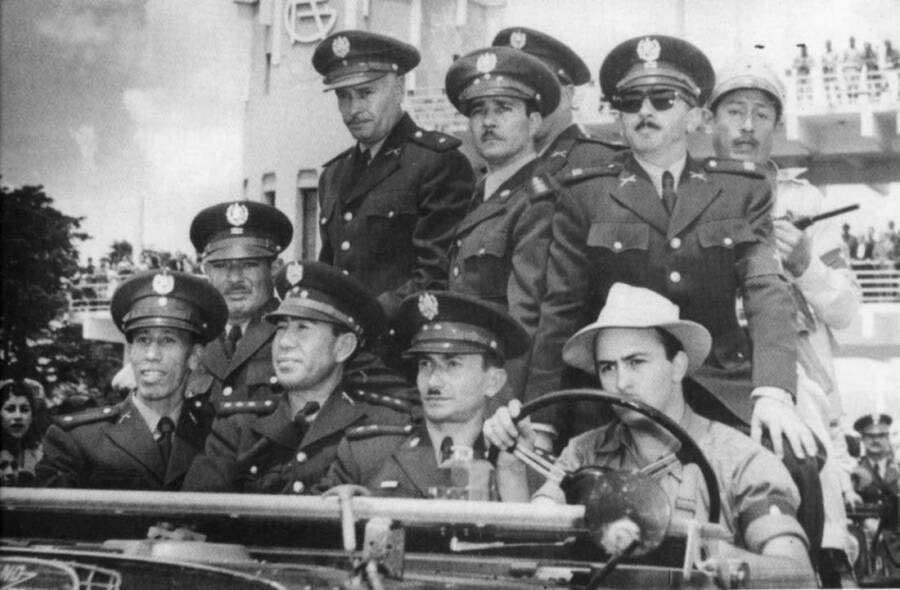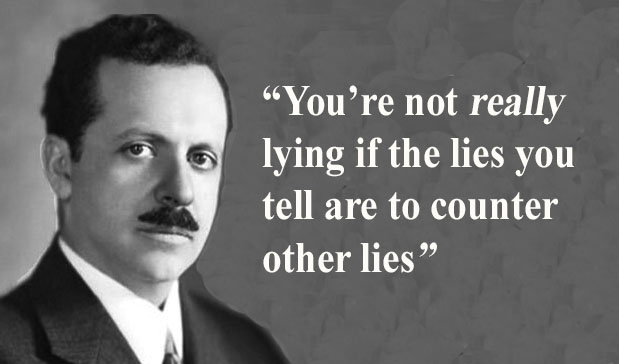The 1954 Guatemalan coup d'état deposed the democratically elected Guatemalan President Jacobo Árbenz and marked the end of the Guatemalan Revolution.
CIA and Assassinations: The Guatemala 1954 Documents
Edited by Kate Doyle and Peter Kornbluh
National Security Archive Electronic Briefing Book No. 4
For more information contact:
Kate Doyle or Peter Kornbluh at202/994-7000 or nsarchiv@gwu.edu
Washington, D.C. – These documents, including an instructional guide on assassination found among the training files of the CIA's covert "Operation PBSUCCESS," were among several hundred records released by the Agency on May 23, 1997 on its involvement in the infamous 1954 coup in Guatemala. After years of answering Freedom of Information Act requests with its standard "we can neither confirm nor deny that such records exist," the CIA has finally declassified some 1400 pages of over 100,000 estimated to be in its secret archives on the Guatemalan destabilization program. (The Agency's press release stated that more records would be released before the end of the year.) An excerpt from the assassination manual appears on the Op-Ed page of The New York Times on Saturday, May 31, 1997.
The small, albeit dramatic, release comes more than five years after then CIA director Robert Gates declared that the CIA would "open" its shadowy past to post-cold war public scrutiny, and only days after a member of the CIA's own historical review panel was quoted in the New York Times as calling the CIA's commitment to openness "a brilliant public relations snow job." (See Tim Weiner, "C.I.A.'s Openness Derided as a 'Snow Job'," The New York Times, May 20, 1997, p. A16)
Arbenz was elected President of Guatemala in 1950 to continue a process of socio- economic reforms that the CIA disdainfully refers to in its memoranda as "an intensely nationalistic program of progress colored by the touchy, anti-foreign inferiority complex of the 'Banana Republic.'"
The first CIA effort to overthrow the Guatemalan president--a CIA collaboration with Nicaraguan dictator Anastacio Somoza to support a disgruntled general named Carlos Castillo Armas and codenamed Operation PBFORTUNE--was authorized by President Truman in 1952. As early as February of that year, CIA Headquarters began generating memos with subject titles such as "Guatemalan Communist Personel to be disposed of during Military Operations," outlining categories of persons to be neutralized "through Executive Action"--murder--or through imprisonment and exile. The "A" list of those to be assassinated contained 58 names--all of which the CIA has excised from the declassified documents.
PBSUCCESS, authorized by President Eisenhower in August 1953, carried a $2.7 million budget for "pychological warfare and political action" and "subversion," among the other components of a small paramilitary war. But, according to the CIA's own internal study of the agency's so-called "K program," up until the day Arbenz resigned on June 27, 1954, "the option of assassination was still being considered."
While the power of the CIA's psychological-war, codenamed "Operation Sherwood," against Arbenz rendered that option unnecessary, the last stage of PBSUCCESS called for "roll-up of Communists and collaborators." Although Arbenz and his top aides were able to flee the country, after the CIA installed Castillo Armas in power, hundreds of Guatemalans were rounded up and killed.
Between 1954 and 1990, human rights groups estimate, the repressive operatives of sucessive military regimes murdered more than 100,000 civilians.
DOCUMENTS
Document 1: "CIA and Guatemala Assassination Proposals, 1952-1954", CIA History Staff Analysis by Gerald K. Haines, June 1995.
CIA records on assassination planning in Guatemala were first gathered pursuant to a Freedom of Information Act lawsuit filed in 1979. All of them were withheld on national security grounds at that time. In 1995, the CIA's historical staff "rediscovered" these records during a search of Guatemala materials to be declassified as part of the agency's "Openness" program. A staff historian, Gerald Haines, was assigned to write this brief history of these operations. He concluded that as early as January 1952, CIA headquarters began compiling lists of individuals in Arbenz's government "to eliminate immediately in event of [a] successful anti-Communist coup." Planning for assassination included budgeting, training programs, creation of hit teams, drafting of target lists of persons, and transfer of armaments. Haines writes that "until the day that Arbenz resigned in June 1954 the option of assassination was still being considered." The CIA, according to this history, did not implement its assassination strategy. But the declassifiers of this study, and other related documents, have deleted the names of the targeted individuals, making it impossible to verify that none of them were killed during or in the aftermath of the coup.
Document 2: "A Study of Assassination", Unsigned, Undated.
Among the documents found in the training files of Operation PBSUCCESS and declassified by the Agency is a "Study of Assassination." A how-to guide book in the art of political killing, the 19-page manual offers detailed descriptions of the procedures, instruments, and implementation of assassination. "The simplest local tools are often much the most efficient means of assassination," counsels the study. "A hammer, axe, wrench, screw driver, fire poker, kitchen knife, lamp stand, or anything hard, heavy and handy will suffice." For an assassin using "edge weapons," the manual notes in cold clinical terms, "puncture wounds of the body cavity may not be reliable unless the heart is reached....Absolute reliability is obtained by severing the spinal cord in the cervical region." T he manual also notes that to provide plausible denial, "no assassination instructions should ever be written or recorded." Murder, the drafters state, "is not morally justifiable," and "persons who are morally squeamish should not attempt it."
Document 3: "Selection of individuals for disposal by Junta Group", March 31, 1954.
One of the many assassination lists compiled by the CIA during planning for Operation Success. As the memorandum indicates, the chief of one of the CIA's divisions involved in the coup (the division title has been deleted) requested a list of names of Arbenz government leaders, members of the Communist Party, and individuals "of tactical importance whose removal for psychological, organizational or others reasons is mandatory for the success of military action." The memo asks that CIA personnel read through the list and initial the names of those who should be included on a "final list of disposees." The list (and the initials or names of all CIA officers appearing in the document) has been withheld. A handwritten note attached on the bottom of the memo reads:
Elimination List
April [illeg.] - [Illeg.] is taking a copy of list of
names for checking with the [illeg.]
April 7 - Original Memo
with attached Biographic data
has been passed to [deleted]
Returned by [deleted] on 1 June 1954
Document 4: "Guatemalan Communist Personnel to be disposed of during Military Operations of Calligeris", Origin deleted, Undated.
Another version of the assassination lists compiled by the CIA and Carlos Castillo Armas (code-named "Calligeris") in the course of preparing for the 1954 coup. The names of the agency's intended victims were divided into two categories: persons to be disposed of through "Executive action" (i.e., killed) and those to be imprisoned or exiled during the operation. Before releasing this document to the public, the CIA deleted every name, leaving only the rows of numbers to indicate how many people were targeted.
Document 5: "Operation PBSUCCESS: The United States and Guatemala, 1952- 1954", CIA History Staff document by Nicholas Cullather, 1994. Excerpt.
A narrative history of the CIA's role in planning, organizing and executing the coup that toppled Jacobo Arbenz Guzmán on June 27, 1954. Cullather, now a diplomatic historian at the University of Indiana, worked on contract for one year with the CIA, where he was given access to thousands of agency records and secret operational files in order to produce this overview. The result is a surprisingly critical study of the agency's first covert operation in Latin America. Beginning with a review of the political, economic and social forces that led to Arbenz's presidency in 1951, the document is an intimate account of how cold war concerns convinced President Eisenhower to order the removal of the democratically-elected leader by force. It also provides countless new details of a covert mission plagued by disastrous military planning and failed security measures: according to Cullather, "Operation Success" barely succeeded. The CIA scrambled to convince the White House that it was an unqualified and all but bloodless victory, however. After Arbenz resigned, Eisenhower called the Director of Central Intelligence, Allan W. Dulles, and his senior covert planners into a formal briefing of the operation. Cullather's account now reveals that the agency lied to the president, telling him that only one of the rebels it had backed was killed. "Incredible," said the president. And it was. At least four dozen were dead, according to the CIA's own records. Thus did the Guatemala coup enter agency lore as an "unblemished triumph," Cullather explains, and become the model for future CIA activities in Latin America.
In Guatemala, of course, "Operation Success" had a deadly aftermath. After a small insurgency developed in the wake of the coup, Guatemala's military leaders developed and refined, with U.S. assistance, a massive counterinsurgency campaign that left tens of thousands massacred, maimed or missing.





![DVIDS - Images - US soldiers trek through the jungle with Guatemala special forces [Image 12 of 12]](https://d1ldvf68ux039x.cloudfront.net/thumbs/photos/1907/5602030/1000w_q95.jpg)





No comments:
Post a Comment